Metabolic Reprogramming and Inflammatory Response Induced by D-Lactate in Bovine Fibroblast-Like Synoviocytes Depends on HIF-1 Activity
- PMID: 33796579
- PMCID: PMC8007789
- DOI: 10.3389/fvets.2021.625347
Metabolic Reprogramming and Inflammatory Response Induced by D-Lactate in Bovine Fibroblast-Like Synoviocytes Depends on HIF-1 Activity
Abstract
Acute ruminal acidosis (ARA) occurs after an excessive intake of rapidly fermentable carbohydrates and is characterized by the overproduction of D-lactate in the rumen that reaches the bloodstream. Lameness presentation, one of the primary consequences of ARA in cattle, is associated with the occurrence of laminitis and aseptic polysynovitis. Fibroblast-like synoviocytes (FLS) are predominant cells of synovia and play a key role in the pathophysiology of joint diseases, thus increasing the chances of the release of pro-inflammatory cytokines. Increased D-lactate levels and disturbances in the metabolism of carbohydrates, pyruvates, and amino acids are observed in the synovial fluid of heifers with ARA-related polysynovitis prior to neutrophil infiltration, suggesting an early involvement of metabolic disturbances in joint inflammation. We hypothesized that D-lactate induces metabolic reprogramming, along with an inflammatory response, in bovine exposed FLS. Gas chromatography-mass spectrometry (GC-MS)-based metabolomics revealed that D-lactate disrupts the metabolism of bovine FLS, mainly enhancing glycolysis and gluconeogenesis, pyruvate metabolism, and galactose metabolism. The reverse-transcription quantitative PCR (RT-qPCR) analysis revealed an increased expression of metabolic-related genes, including hypoxia-inducible factor 1 (HIF-1)α, glucose transporter 1 (Glut-1), L-lactate dehydrogenase subunit A (L-LDHA), and pyruvate dehydrogenase kinase 1 (PDK-1). Along with metabolic disturbances, D-lactate also induced an overexpression and the secretion of IL-6. Furthermore, the inhibition of HIF-1, PI3K/Akt, and NF-κB reduced the expression of IL-6 and metabolic-related genes. The results of this study reveal a potential role for D-lactate in bFLS metabolic reprogramming and support a close relationship between inflammation and metabolism in cattle.
Keywords: D-lactate; bovine fibroblast-like synoviocyte; hypoxia inducible factor 1; inflammation; metabolic reprogramming.
Copyright © 2021 Quiroga, Alarcón, Manosalva, Teuber, Taubert, Hermosilla, Hidalgo, Carretta and Burgos.
Conflict of interest statement
The authors declare that the research was conducted in the absence of any commercial or financial relationships that could be construed as a potential conflict of interest.
Figures


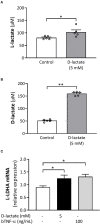
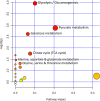

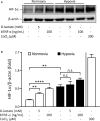
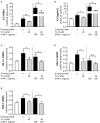
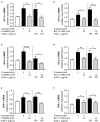

Similar articles
-
Andrographolide Ameliorates Inflammatory Changes Induced by D-Lactate in Bovine Fibroblast-like Synoviocytes.Animals (Basel). 2024 Mar 19;14(6):936. doi: 10.3390/ani14060936. Animals (Basel). 2024. PMID: 38540033 Free PMC article.
-
Bovine tumor necrosis factor-alpha Increases IL-6, IL-8, and PGE2 in bovine fibroblast-like synoviocytes by metabolic reprogramming.Sci Rep. 2023 Feb 24;13(1):3257. doi: 10.1038/s41598-023-29851-y. Sci Rep. 2023. PMID: 36828912 Free PMC article.
-
D-Lactate Increases Cytokine Production in Bovine Fibroblast-Like Synoviocytes via MCT1 Uptake and the MAPK, PI3K/Akt, and NFκB Pathways.Animals (Basel). 2020 Nov 13;10(11):2105. doi: 10.3390/ani10112105. Animals (Basel). 2020. PMID: 33202791 Free PMC article.
-
d-lactate-triggered extracellular trap formation in cattle polymorphonuclear leucocytes is glucose metabolism dependent.Dev Comp Immunol. 2022 Oct;135:104492. doi: 10.1016/j.dci.2022.104492. Epub 2022 Jul 10. Dev Comp Immunol. 2022. PMID: 35830898 Review.
-
Metabolic phenotype of bladder cancer.Cancer Treat Rev. 2016 Apr;45:46-57. doi: 10.1016/j.ctrv.2016.03.005. Epub 2016 Mar 8. Cancer Treat Rev. 2016. PMID: 26975021 Review.
Cited by
-
LncRNA-MCM3AP-AS1 Promotes the Progression of Infantile Hemangiomas by Increasing miR-138-5p/HIF-1α Axis-Regulated Glycolysis.Front Mol Biosci. 2021 Sep 29;8:753218. doi: 10.3389/fmolb.2021.753218. eCollection 2021. Front Mol Biosci. 2021. PMID: 34660700 Free PMC article.
-
Andrographolide Ameliorates Inflammatory Changes Induced by D-Lactate in Bovine Fibroblast-like Synoviocytes.Animals (Basel). 2024 Mar 19;14(6):936. doi: 10.3390/ani14060936. Animals (Basel). 2024. PMID: 38540033 Free PMC article.
-
Lactic Acid Regulation: A Potential Therapeutic Option in Rheumatoid Arthritis.J Immunol Res. 2022 Aug 24;2022:2280973. doi: 10.1155/2022/2280973. eCollection 2022. J Immunol Res. 2022. PMID: 36061305 Free PMC article. Review.
-
Pyruvate dehydrogenase kinases: key regulators of cellular metabolism and therapeutic targets for metabolic diseases.J Physiol Biochem. 2025 Feb;81(1):21-34. doi: 10.1007/s13105-025-01068-9. Epub 2025 Mar 21. J Physiol Biochem. 2025. PMID: 40117090 Review.
-
Bovine tumor necrosis factor-alpha Increases IL-6, IL-8, and PGE2 in bovine fibroblast-like synoviocytes by metabolic reprogramming.Sci Rep. 2023 Feb 24;13(1):3257. doi: 10.1038/s41598-023-29851-y. Sci Rep. 2023. PMID: 36828912 Free PMC article.
References
LinkOut - more resources
Full Text Sources
Other Literature Sources
Miscellaneous

